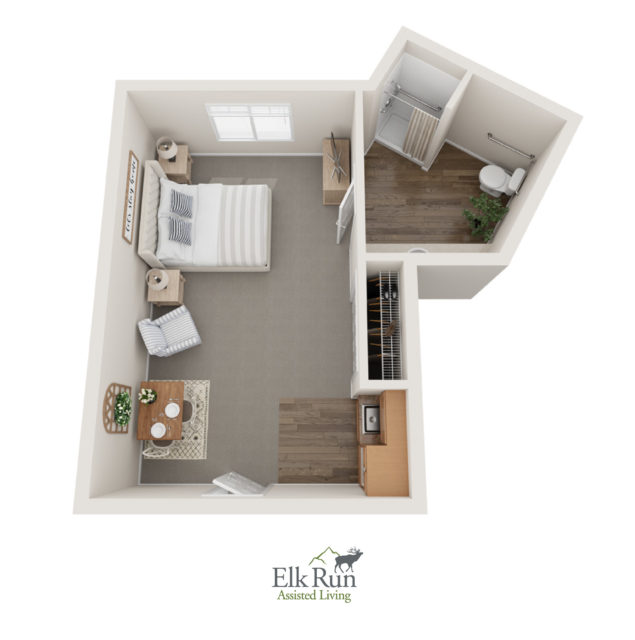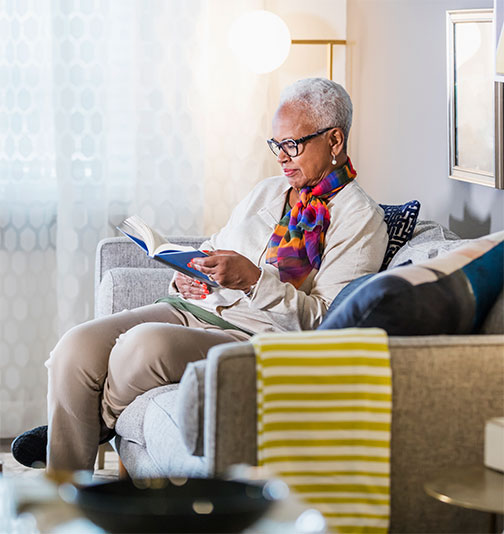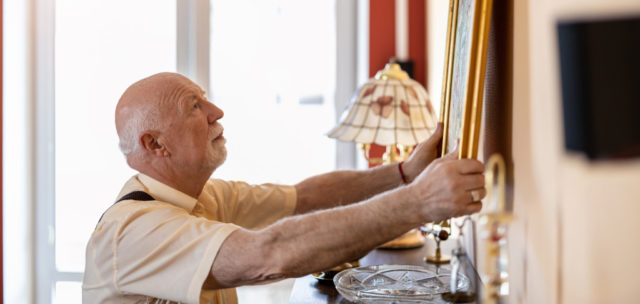Are you or a loved one getting ready for a move to assisted living? Have you considered how you’re going to decorate? It may seem unimportant, but setting up an inviting space can be one of the most important things you do.
Moving to a new home or apartment at any age isn’t easy. Leaving a home filled with memories of celebrations and family life can feel like you’re leaving part of yourself behind.
Decorating a new assisted living apartment with items and pictures from home can make all the difference. Favorite photos, music, heirlooms, books and furniture allow us to bring precious memories with us. An inviting, familiar environment can help tremendously when someone is transitioning from a long-time home to a new one.
If your parent, grandparent or another loved one is moving, it’s important to involve him or her in the planning process. Ask for advice on a color scheme or discuss what items should come along to a new home.
The good news is that you don’t have to be an interior designer to create a space that fits your personality. I want to share a few tips with you to help you feel more confident about setting up an apartment in an assisted living community.

- Consult your floor plan. Most assisted living apartments offer floor plans (along with virtual or in-person tours) so you can figure out what furniture you’ll need and where it should be placed. Often, houses contain more furniture than an assisted living apartment can accommodate—so it’s likely you or a loved one will have to give away or sell some furniture before moving.
- Work on preventing falls. Balance can be challenging for older adults, especially if they are in an unfamiliar environment. That’s why pathways should be clear of cords, loose area rugs and other items that might easily cause someone to trip.
- Organize rooms and areas. Making it easy to locate items improves how we function in our living spaces. Use baskets, boxes, wall hooks and shelves to collect similar items in each room. Make sure it is easy to see what is stored in each organizational area. You also don’t want a loved one to stoop or climb to get to shelving, baskets or hooks.
- Choose function over form. Comfortable, functional pieces can be beautiful and helpful at the same time. Too many knickknacks, on the other hand, will clutter up your space and make it hard to find things when you need them. If you can, include pieces that offer storage, such as a window bench that opens to store photo albums inside it. Pieces that do double duty are good choices too, such as a bed frame that contains drawers for your clothes.

- Purchase assistive furniture. There are chairs that will provide extra support to help you get up—or power recliners that relieve pressure and are more comfortable than conventional chairs.
- Set up a safe bathroom environment. Wet floors are especially hazardous in bathrooms. Assisted living communities like Elk Run typically have grab bars in showers and above toilets. Bathmats should have rubber grips so they don’t slide out from under you. Installing hooks so you can hang up towels and robes is also essential for safety’s sake.
- Bring easy-care plants. Plants that don’t require too much fussing are ideal for assisted living apartments. Greenery adds color and a homey feel to most every living space.
- Make room for personal passions. You or a loved one may be an artist, enjoy building model boats or play saxophone. Create a space for these passions and whatever supplies are needed to facilitate them. Community spaces are usually available, but it’s crucial to have space for projects that mean the most to us in our own homes.
- Personalize your space. Everyone has his or her own personal preferences and style, which should be honored. Floor cushions, curtains, artwork, plants and colors allow us to create the kind of spaces that make us feel joyous and at home. Items that have a history or tell a story will add even more beauty and character to a new home.
- Make sure there’s enough light. Besides having enough natural light during the day for hobbies and activities, you’ll want to be sure of good lighting on drearier days. It’s also important to have sufficient nighttime lighting, so getting to the bathroom or kitchen is safe and easy. In addition, be careful about lamp cords—and be sure they are visible and out of the way, so you don’t trip on them.
Last but not least:
- Choose higher chairs with arms in your living room so it’s easier to get in and out of them.
- Dress up your bed with comfortable sheets, pillows and blankets.
- Consider a memo board you can use to remember tasks or phone numbers.
Most of all, have fun! Moving to assisted living can be an opportunity to explore new friendships and possibilities. Creating a functional, personal living space will help you make the most of it.








